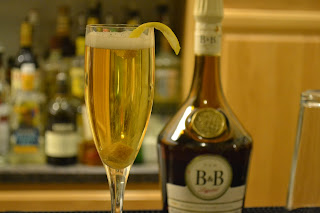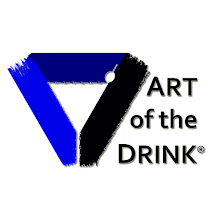Saturday, May 31, 2014
Friday, March 21, 2014
Earth Day Cocktail - AOTD 82
For Earth Day, Art of the Drink teams up with Glass Dharma to bring you a cocktail that's as eco-friendly as it is delicious!
Labels:
cocktail,
drinks,
earth day,
gin,
st germain
Location:
New York, NY, USA
Talking Pisco with Junior Merino - AOTD 81
Here's one from the vaults that was never released! Junior Merino and I visit the Pisco Porton distillery in Ica, Peru, for the brand launch, and I have the chance to get his take on all things Pisco!
Monday, February 11, 2013
Maker's Mark ABV
I've been getting asked a lot about my thoughts on the Maker's Mark announcement that they'll be cutting the ABV from 45 percent to 42 percent in order to meet the high demand for their Bourbon, so here they are:
Basically, there seems to be lots of media hype over nothing, though I don't know if I agree with the distillery's decision. They could take the ABV down to 40 percent with no problem unless you're drinking it neat (which most people aren't). A difference of more than 3 percent ABV is already introduced by variations in ice quantity and melt rate (due to both ice temp and ambient temp), as well as differences in mixer volumes. I guarantee if you've had two Maker's and gingers in an average bar, they varied by more than 3 percent. Have it straight on the rocks and the ABV passes through 42 percent as you're drinking it -- and then keeps going down as the ice melts. If a 3 percent reduction in ABV compromises the product, then I've rarely had it uncompromised.
Having said that, I would have preferred they maintain the formula and play up the shortage, Cabbage Patch Kids-style. IMO, the last thing you ever want to do is alter your product, though I'm sure they know and considered that. I guess the question then becomes, would MM drinkers have preferred a price increase to an ABV decrease? I probably would have, but let me know if you have thoughts on this -- thanks!
Tuesday, January 22, 2013
Invert Syrup: A Primer
Invert syrups are commonly used to sweeten liqueurs and cordials, though most consumers don't have a good understanding of what they are or how they are made.
Definition
Invert syrup is a sugar syrup composed of equal parts glucose (C6H12O6) and fructose (C6H12O6), derived from splitting a solution of sucrose (C12H22O11) in water (H2O) into these component parts.
Name Derivation
The concentration of a sugar syrup can be measured by passing polarized light (light whose waves are all aligned in a single plane which can be measured before and after it enters the syrup) through the solution and measuring the degree of light wave rotation upon exiting. A solution of pure sucrose will rotate the light 66.5 degrees to the right, and as the sucrose is converted into glucose and fructose the exiting light will begin rotating to the left. A fully converted sugar will have an exit rotation of 39 degrees to the left. This inversion of the rotation from right to left gives the converted syrup its name.
Other Names
Inverted syrup, trimoline.
Process
Sucrose is a disaccharide, which indicates that it is composed of two simpler monosaccharides (glucose and fructose). By heating a solution of sucrose in water, a hydrolysis reaction is induced which splits the disaccharide into its two component parts. By adding an acid catalyst such as lemon juice (10ml per kg sugar) or cream of tartar (1g per kg sugar), the reaction can be accelerated. Pastry chefs often make invert syrup by cooking sucrose syrup with an acid until a thicker syrup is formed (e.g., boiling a sucrose/acid solution for 20 minutes at 237°F). Invert syrup can be made in varying thicknesses based on the ratio of sugar to water, and can be converted to varying degrees (up to about 85% glucose/fructose) based on the reaction time.
Naturally Occurring Forms
Honey, jams.
Color
Light to medium gold.
Taste
Noticeably sweeter than sucrose.
Advantages
-Invert syrup will resist crystallization longer than sucrose syrup.
-If invert syrup begins to solidify, it can be re-liquefied by warming gently.-Invert syrup will resist crystallization longer than sucrose syrup.
-Invert syrup creates products that are smoother and less granular than sucrose syrup.
-Invert syrup retains more moisture than sucrose syrup, so it adds preservative qualities to products and has a longer shelf life.
-Invert syrup is an important ingredient in low-fat goods, as it replaces the moisture content that would be provided by fat.
-All constituent sugars (sucrose, glucose, and fructose) support fermentation, so invert syrup can be fermented as easily as sucrose syrup.
Monday, December 31, 2012
Tuesday, September 11, 2012
Shaking With Craft Ice
Good question from across the pond!
Q: Anthony, any thoughts on using a single piece of craft ice in place of cubed ice for shaking? I've heard that shaking with craft ice provides a better (finer/silkier) texture for sours as it creates fewer ice shards that break up the egg proteins in the drink.
A: I haven't done any controlled research on shaking with craft ice, though my experience tells me it would defeat the point of choosing shaking over other chilling methods (e.g., stirring). The three main reasons to choose shaking are:
1. Aeration;
2. Creation of ice chips; and
3. Faster chilling.
All three of the above outcomes are improved with cubed ice versus one large piece of craft ice. Aeration is dependent on the number of solid bodies breaking the liquid surface tension to introduce air, so clearly many smaller cubes would be more effective than a single large cube (smaller bodies are also more effective at aeration than larger bodies, so this would be a corollary advantage for cubed ice). Creation of ice chips increases with increased surface area exposed to impact so here again cubed ice would come out ahead, and chilling speed (both convective and conductive, the two methods that are active during shaking) is also tied to surface area -- the greater surface area of many smaller cubes chills faster than the smaller surface area of one larger cube.
This being the case, it seems that a single large piece of craft ice would be a poor choice to use for shaking: the advantages of craft ice (smaller surface area, decreased melting/dilution) are directly in opposition to the goals that shaking is trying to achieve. Using craft ice may make more sense for stirring, in which the bartender is trying to minimize aeration and ice chips, but chilling would be slowed. Regarding drink texture, aeration is what creates the silky texture we all love in drinks that include egg or other proteins -- the bartender is essentially beating the eggs. The best way to eliminate ice shards is to double-strain the drink not decrease the efficiency of aeration, which would just require that the bartender shake the drink longer to achieve the same consistency.
It's probably best to remember the original intention of large pieces of craft ice, namely, to hold pre-chilled liquids at temperature. Once a drink has been cooled to service temperature, a single large piece of ice is quite capable of keeping it at that temperature with a minimum of additional dilution. However, craft ice is usually an ineffective tool for initially bringing a drink to service temperature.
Q: Anthony, any thoughts on using a single piece of craft ice in place of cubed ice for shaking? I've heard that shaking with craft ice provides a better (finer/silkier) texture for sours as it creates fewer ice shards that break up the egg proteins in the drink.
A: I haven't done any controlled research on shaking with craft ice, though my experience tells me it would defeat the point of choosing shaking over other chilling methods (e.g., stirring). The three main reasons to choose shaking are:
1. Aeration;
2. Creation of ice chips; and
3. Faster chilling.
All three of the above outcomes are improved with cubed ice versus one large piece of craft ice. Aeration is dependent on the number of solid bodies breaking the liquid surface tension to introduce air, so clearly many smaller cubes would be more effective than a single large cube (smaller bodies are also more effective at aeration than larger bodies, so this would be a corollary advantage for cubed ice). Creation of ice chips increases with increased surface area exposed to impact so here again cubed ice would come out ahead, and chilling speed (both convective and conductive, the two methods that are active during shaking) is also tied to surface area -- the greater surface area of many smaller cubes chills faster than the smaller surface area of one larger cube.
This being the case, it seems that a single large piece of craft ice would be a poor choice to use for shaking: the advantages of craft ice (smaller surface area, decreased melting/dilution) are directly in opposition to the goals that shaking is trying to achieve. Using craft ice may make more sense for stirring, in which the bartender is trying to minimize aeration and ice chips, but chilling would be slowed. Regarding drink texture, aeration is what creates the silky texture we all love in drinks that include egg or other proteins -- the bartender is essentially beating the eggs. The best way to eliminate ice shards is to double-strain the drink not decrease the efficiency of aeration, which would just require that the bartender shake the drink longer to achieve the same consistency.
It's probably best to remember the original intention of large pieces of craft ice, namely, to hold pre-chilled liquids at temperature. Once a drink has been cooled to service temperature, a single large piece of ice is quite capable of keeping it at that temperature with a minimum of additional dilution. However, craft ice is usually an ineffective tool for initially bringing a drink to service temperature.
Friday, August 03, 2012
Drambuie Tales-on-Tap $10,000 Finals!
Check out the Drambuie Tales-on-Tap $10,000 Draft Cocktail Competition Finals at this year's Tales of the Cocktail!
Subscribe to:
Posts (Atom)

